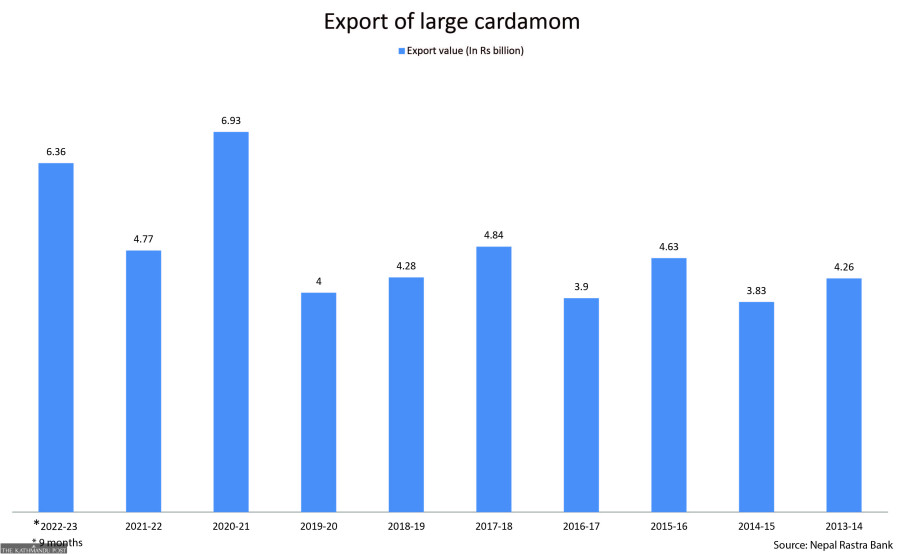Money
Large cardamom exports hit record Rs6.36 billion in 9 months
Nepal is the world’s largest producer of the high-value spice followed by India and Bhutan.
Krishana Prasain
Nepal cemented its place as the world’s largest cardamom exporter by shipping an all-time high Rs6.36 billion worth of the spice in the first nine months of the current fiscal year.
According to the Trade and Export Promotion Centre, exports jumped by 65 percent year-on-year to 7,871 tonnes largely due to an increase in production.
Traders say the export value of large cardamon may hit an annual high by the end of the fiscal year in mid-July.
Large cardamom is cultivated predominantly in four districts of eastern Nepal—Taplejung, Panchthar, Ilam and Sankhuwasabha—which account for more than 80 percent of national production. Around 60,000 families are involved in growing it.
Besides Nepal, this high-value spice is also cultivated in India and Bhutan.
More than 90 percent of the large cardamom grown in Nepal is exported to India, traders said. The spice is also sent to Pakistan.
Large cardamom exports account for 5.4 percent of Nepal’s total exports.
“This year, production increased by 50 percent as the saplings planted four years ago started to bear fruits,” said Nirmal Bhattarai, president of the Large Cardamom Entrepreneurs Association of Nepal.
“Farmers are expanding the large cardamom acreage beyond the eastern hill districts.”
Large cardamom is being grown in Dadeldhura and Lamjung too. Favourable weather also helped to boost output, he said.
According to the association, large cardamom sells for Rs850 per kg. The farmgate price is lower.
“The price of large cardamom has been fluctuating in a range of Rs700 to Rs1,000 per kg,” said Bhattarai who also owns Everest Large Cardamom Industries in Arjundhara, Jhapa.
Large cardamom is grown on 18,000 hectares in the country. The spice is harvested between mid-July and mid-October.
“We have been processing large cardamom for export, but India prefers non-processed cardamom as it is cheaper. India then processes, packages and brands the spice and sells it at a higher price,” Bhattarai said.
“Everest Large Cardamom Industries is engaged in processing, packaging and labelling large cardamom,” he said.
“We are trying to export large cardamom to third countries by doing the processing, packaging and branding ourselves. Domestic consumption of large cardamom is minimal, so the association is trying to increase consumption too.”
Export earnings from goods identified by the Nepal Trade Integration Strategy (NTIS) 2016 as having high export potential increased by 18 percent in the first nine months of the current fiscal year, with carpet, cardamom, tea, pashmina, medicinal herbs and ginger recording sharp increases.
Nepal earned Rs32 billion from exports of NTIS products in the first nine months of the current fiscal year, the Trade and Export Promotion Centre revealed.
Export earnings from NTIS products totalled Rs36.89 billion in the last fiscal year year 2021-22.
Cardamom, tea, ginger, yarns, carpet, pashmina, medicinal herbs, textiles, footwear and leather are included in the latest NTIS product list.
The primary market for NTIS-listed farm products is India. Europe and the United States are the largest buyers of NTIS-listed handicraft goods.
The NTIS is normally reviewed every five years. Items on the list get special privileges for export.
The government is reviewing the NTIS for the third time after it failed to boost exports amid a changing global trade landscape. Officials said the strategy failed to increase exports mainly due to lack of coordination among government bodies.
Growth in the export of listed products will happen when the Finance and Industry ministries and its agencies like the Department of Commerce, Supplies and Consumer Protection coordinate their activities, they said.
Nepal developed and adopted the NTIS 2010 as an updated version of the Nepal Trade and Competitiveness Study 2004 that focused on the development of 12 goods and seven services to contribute to the poverty reduction goal by making trade inclusive and equitable.
The government rolled out the NTIS to increase and promote exports to narrow the trade deficit. But even after a decade, exports have been pathetic, insiders said.
Nepali large cardamom or black cardamom has a distinct flavour profile due to a specific method of postharvest drying in bhattis (ovens), which explains the roasted smell and taste. The smoky flavour would overwhelm a sweet cake or pudding, but in a spice rub for roasted meat or in a full-flavoured stew, it imparts a smouldering depth no other spice can, according to experts.




 17.12°C Kathmandu
17.12°C Kathmandu













%20(1).jpg&w=300&height=200)
